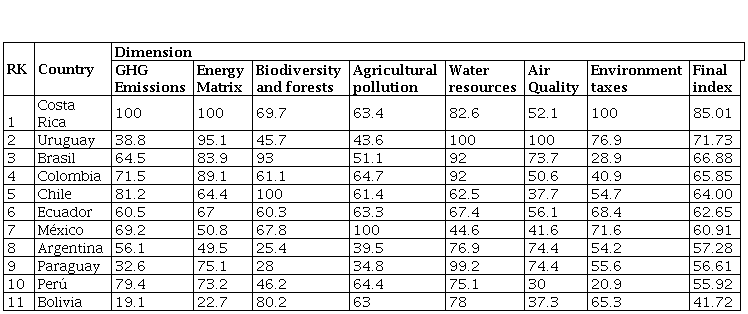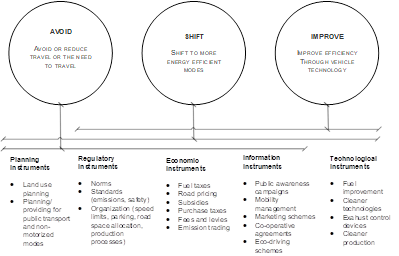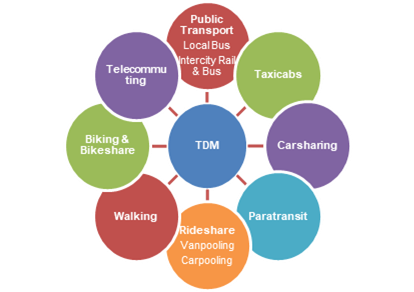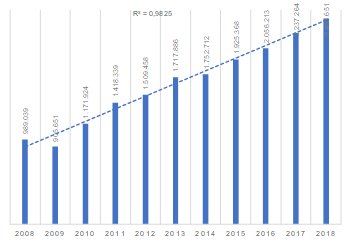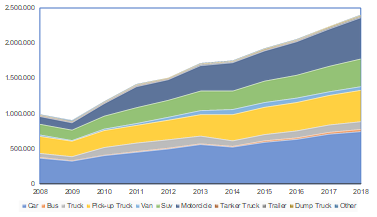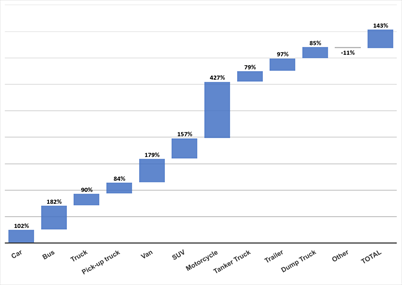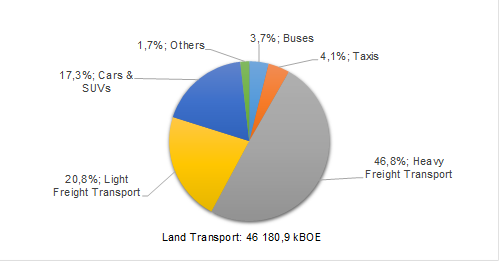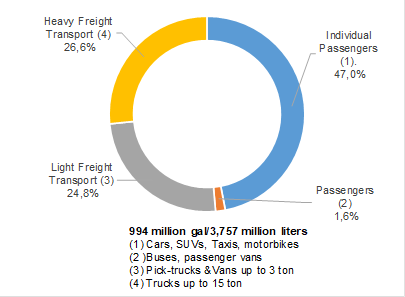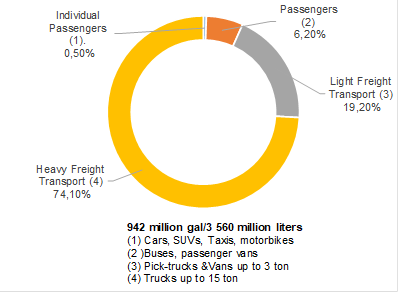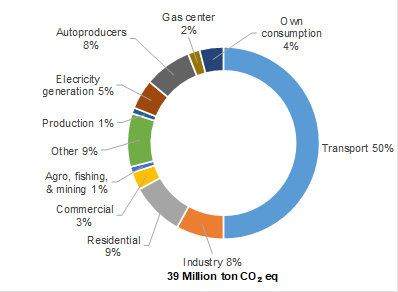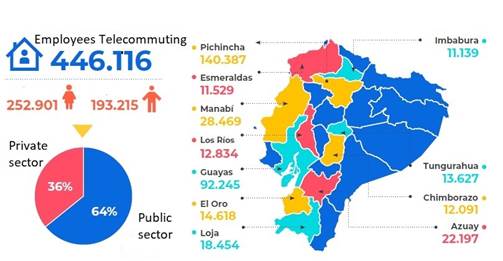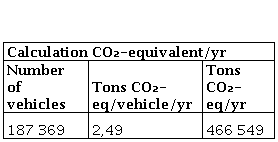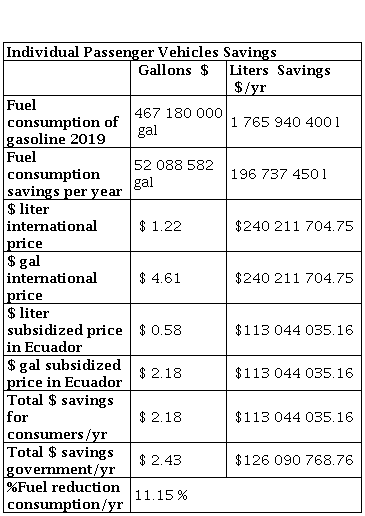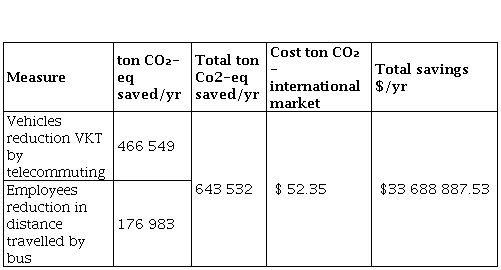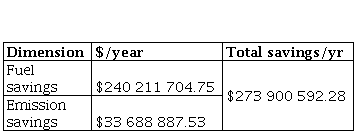1. Introduction
The importance to attain sustainable development is crucial for the progress of countries and inhabitant’s improvement quality of life. Thus, telecommuting is a tool that needs to have continuity to evaluate the benefits in the public and private sector. It is a term that is covered in various disciplines such as transportation, economics, sociology or even in law; which has generated different definitions(Navarrete Rojas, 2014). For the first time it was proposed by the American physicist Jack Nilles in 1973 (Corbi, 2014) during the oil peak of the 1970s and defined it in 1976 as: “any form of substitution of displacements related to work activity by technologies of the information” or more explicitly “the possibility of sending the job to the worker, instead of sending the worker to the job” (Navarrete Rojas, 2014, p. 46). The purpose of this initiative was to reduce the consumption of fuel used for commuting to workplaces. On the other hand, the International Labor Organization defined telecommuting in 1990 as one that “is carried out in a distant place from the central office or the production center and it involves a new technology that allows separation and facilitates information” (Navarrete Rojas, 2014, p. 46).
Hence, telecommuting has been used for a long time worldwide, and it has been applied to public and private work spaces, due to the health crisis since 2020, and Ecuador has promoted telecommuting through the Ecuadorian Ministry of Labor, to guarantee the safety of workers who can take advantage of this approach.
Nonetheless, telecommuting can also be seen as either a sustainable transportation or sustainable mobility approach, considering that it refers to the provision of infrastructure, services, technologies, and information that allow access to goods and services, in the involvement of activities in such a way that they allow the continuous access and participation of future generations (Budnitz, 2019). Alongside, British professor Robin Hickman defines Sustainable mobility as “a means to access activities, within environmental limits and in an equitable manner” (Hickman & Banister, 2019, p. 29).
Sustainable mobility from the economic point of view must ensure the connection between workers and workplaces; the productive chain, and consumers. From the social point of view, it must guarantee to provide equitable, affordable access to good and services, employment, education, in order to promote a healthy life and cohesion among communities, and at the same time be able to reduce any personal risks (Budnitz, 2019).
Therefore, this study analyses telecommuting as a measure for sustainable transport in Ecuador, taking into consideration the social, economic, and environmental elements in the Ecuadorian context.
1.1. Related work
It is imperative to mention that telecommuting has been used extensively worldwide, and it has taken special attention and application in developing countries due to the global health crisis. For this reason, a variety of articles published recently have been analyzed to determine the benefits that can be associated with sustainable transportation.
The article developed by (O’Brien & Aliabadi, 2020), shows evidence on the fact that there are advantages associated with telecommuting, that can reduce commuting time, distance travelled, cost reductions, the reduction of traffic, and GHG emissions; likewise (Cerqueira et al., 2020), also indicates that telecommuting can contribute for managing travel demand, in order to reduce traffic congestion, and GHG emissions; and Mouratidis, Peters & van Wee (2021) share the same advantages on telecommuting.
There is non-energy related benefits such as, the reduction of stress, healthier lifestyles, increasing morale and productivity, among others, according to O’Brien & Yazdani Aliabadi (2020), also it analyzes four domains: transportation and urban forms, offices, homes, and information and communication technology. O´Brien & Aliabadi (2020) and Cerqueira et al. (2020) indicate that there are rebound effects related to the increase of non-work related trips that might be influenced by travel patterns.
From the point of view of policy implementation and measures, Venturini, Karlsson & Münster (2019) analyze the effectiveness of transport policy measures from a holistic point of view, considering telecommuting part of the interventions to achieve sustainable mobility in the case study of Denmark, where telecommuting is considered to accommodate passenger travel demand as a soft measure that requires identification of potential user groups targeting behavioral travel changes to reduce commuting travel demand. Zhang & Zhang (2021) conclude that one of the main policy implications is the radical change of the population´s lifestyle to promote the decarbonization of the transport sector by implementing policies that encourage telecommuting, along with energy improvements on the transport sector, urban planning and land use regulation, in order to obtain resilient, and sustainable cities in the post COVID world. Alongside, Godínez-Zamora et al. (2020) indicate that a variety of measures to attain a deep decarbonization that include energy efficiency, the adoption of electro mobility, the modal shift to public transportation, active mobility, and teleworking could allow a 25 % reduction of energy production by 2050 in the case of Costa Rica.
According to Giovanis (2018), the conclusion is that teleworking has a positive effect and the application results can vary according to the characteristics of every country i.e. social, political, economic, demographic, and cultural, and it is recommended as a measure for urban planning, and air urban quality improvement. It is stated “in this case teleworking can be a viable short- and long-term solution to emissions, fuel consumption and traffic congestion reduction, especially in the urban areas and an important tool for the quality of life improvement.” (Giovanis, 2018, p. 12), There are other positive effects of teleworking that need to be analyzed such as, well-being, productivity and public health, employees, employers and the society overall, as the environment and public health, hospital admissions, productivity, and well-being.
Besides the positive effects mentioned, (Dima, Tuclea, Vranceanu & Tigu, 2019) state that telework could generate job opportunities for women with children and reduce unemployment in rural areas considering the sustainable social implications.
Teleworking in Ecuador has some benefits established by the Ministry of Labor, and consist of the following from the teleworker point of view: improvement of personal environment, productivity, responsibility, health, work time optimization. On the contrary, the benefits for the institutions include: reduction of space and costs on leasing, elimination of costs related to transportation and uniforms, achievement of management goals, more productivity and committed staff. Finally, the benefits for society are reduction of traffic, GHG emissions, reduction on travel times, more opportunities for vulnerable groups, and better family relationships (Morales López & Pérez Sisa, 2020).
2. Methodology
For the development of this research a descriptive approach was used to determine the energy savings, the amount of greenhouse gases avoided, and the monetary savings that can be obtained through the implementation of telecommuting. The information used for the investigation was based on the Ecuadorian National Energy Balance 2019, where the annual gasoline consumption in gallons is considered. Also, information from the National Institute of Statistics and Censuses is reflected to display the total population, the total automotive fleet, and the National Survey of Income and Expenditure helped determine the average income, as well as, the average spending from the highest deciles of the population; the Ministry of Labor supplied information regarding the amount of employees nationwide. The data from the different institutions aided to develop well-posed hypotheses. On the other hand to determine the carbon footprint a methodology established by the Environmental Protection Agency EPA is taken as a reference (EPA, 2021).
2.1 Sustainable Development
Sustainable development can be achieved with the use of the approaches previously mentioned. It was stated for the first time in the Bruntland report (Report entitled “Our Common Future” 1987, World Commission on Environment and Development) in 1987, and defined as “the development that meets the needs of the present without compromising the ability of future generations to meet their own needs” (United Nations-General Assembly, 1987, p. 54). This report was the base for different organizations worldwide to develop plans e.g. World Wildlife Fund WWF, Greenpeace, and others, and the United Nations have been able to establish the parameters to achieve environmental sustainability through the development of the Sustainable Development Goals SDGs (United Nations, n.d.).
Simultaneously, in 2020 YALE University has developed the Environmental Performance Index EPI, which provides a summary based on sustainability around the world. It uses 32 performance indicators within 11 categories, and ranks 180 countries on environmental health and ecosystem vitality. These indicators provide a national-level indicator of how close countries are to established environmental policy goals and provide practical guidance for countries aspiring to move towards a sustainable future (Yale, 2020).
According to the Environmental Performance Index EPI, and the indicators provided, Ecuador is ranked 56 overall out of 180 countries in the world. In Latin America and the Caribbean, considering 32 countries, Ecuador is in seventh place. Joining efforts on this subject, the América Economía platform has developed for the first time a Latin American sustainability ranking, where greenhouse gas emissions, energy matrix, biodiversity management, agricultural pollution, air quality in urban areas and environmental taxes are analyzed (León De La Barba, 2020). Ecuador is in 6th place among 11 countries selected for this first Latin American ranking edition and it is shown in Table 1.
Nevertheless, neither the Sustainable Development Goals, nor The Environmental Performance Index EPI, nor the Latin American Sustainability Ranking explicitly describe sustainable transportation as a dimension to achieve sustainable development. Considering the elements previously mentioned and the different approaches to attain sustainable transport, it is imperative that they have to be evaluated as a specific dimension in the sustainable development parameters.
2.2 Sustainable Mobility and the ASI Approach
Through time different approaches have been developed to deal with topics related to sustainable mobility. One of them is the ASI approach (Avoid, Shift, Improve). Within which, telecommuting has been considered as a measure to be applied, and obtain benefits as society. The origin of this approach dates back to the early 1990s in Germany, and it was later accepted and applied for the first time in 1994 in the report Enquete emitted by the German parliament. The approach serves as a tool to structure policy measure to reduce the environmental impacts of transport, and thus improve inhabitant’s quality of life. In community development, the ASI approach was first adopted by international NGOs, as well as multilateral, bilateral, and development organizations working on transportation-related problems. It was seen as a valuable alternative to manage the “predict-provide” approach. The ASI approach focuses on the demand side and offers a more holistic intervention to design a complete sustainable transport system (Bongardt, et al., 2019).
The ASI approach encompasses three main pillars, that include mobility management and energy efficiency in the transport sector (Kreuzer & Wilmsmeier, 2014):
1. Avoid. - Avoid or reduce travel or the need to travel by motorized means - Improve the efficiency of the system.
2. Shift. - Shift current mobility towards more efficient modes of transport - Increase travel efficiency.
3. Improve. - Improve fuel efficiency in transportation modes - Increase vehicle efficiency.
These pillars can be seen in Figure 1, which shows the tools that can be implemented to obtain the best results in a process of applying them (Transformative Urban Mobility Initiative TUMI, 2019). Taking the aforementioned, teleworking is within the AVOID pillar, and it proposes avoiding or reducing travel or the need to travel (without travel activity). It is important to mention that there are a variety of instruments that are transversal and can be applied simultaneously. The existing instruments are:
· Planning instruments
· Regulatory instruments
· Economic instruments
· Information instruments
· Technological instruments
For this reason, within the different instruments telecommuting can be classified as an information or communication instrument, which can be articulated through a normative and regulatory instrument for its application, and it can be taken as a sustainable transport measure, which is part of a larger equation of different components that must be articulated through all the institutions that have jurisdiction over traffic, transportation, road safety, and land use planning, among others. The analysis of telecommuting that must be carried out must have a direct link with the reduction of unnecessary trips, which are directly proportional to the reduction of fossil fuels, and the reduction of greenhouse gases GHG. The reduction of fossil fuels and GHG can be quantified in order to obtain results to exemplify that inhabitant’s quality of life can be substantially improved.
2.3 Transport Demand Management TDM
Telecommuting is also considered part of the Transport Demand Management TDM for its acronym. Transport Demand Management (TDM) aims to maximize the efficiency of the urban transport system through a wide range of techniques and strategies, e.g. congestion pricing, improving public transport, promoting non-motorized transport, fuel control, parking management, car sharing, as well as telecommuting (Broaddus, Litman & Menon, 2009), among others, which can be seen in Figure 2 (Mobility Lab, n.d.).
As it was mentioned in the ASI approach, telecommuting is part of holistic measures in the Transport Demand Management TDM, and it must be articulated in a general way through the competent entities to obtain the desired results.
2.4 Ecuador’s Current Situation
Despite the fact that telecommuting has been talked about for a long time, in Ecuador started in 2020 due to the worldwide health crisis, as safety measure to avoid any risks related to COVID-19, which has resulted in a decrease in energy consumption and GHG emissions. However, from the transportation point of view traffic congestion and the growth of the automobile fleet must be analyzed, since they are related to problems that challenge urban and suburban areas; combined with disorderly urban sprawl and the exponential population growth. In Ecuador, around 77,80 % of the total population resides in urban areas and it is expected that by 2030 it will reach 80,60 % (Lattes, 2001). By 2018, according to the Ecuadorian Institute of Statistics and Censuses (INEC), the population of Ecuador was 17.08 million people (INEC, 2019); in the same year, the total registered vehicle fleet was 2 403 651 units, which includes all type of vehicles (INEC, 2020). This information is useful to determine Ecuador’s motorization rate, as it is shown in Ec.1.
The motorization rate in Ecuador in 2019 was 141 vehicles per 1 000 inhabitants. Latin America and the Caribbean had an average of 201 vehicles per 1 000 inhabitants, being one of the highest worldwide together with Asia and the Middle East (Rivas, Suárez-Alem-an & Serebrisky, 2019). Moreover, revising the statically information about the Ecuadorian fleet it can be seen that it has increased linearly at an average of 10 % per year, as it is shown in Figure 3 (Instituto Nacional de Estadística y Censos, 2021). It is expected that the fleet will continue to increase, whereas the road capacity is in a continuous process of saturation, due to the lack of land use planning and articulated projects to benefit pedestrians and bicycle users at the local level.
More graphically the growth of the different types of vehicles in Ecuador annually can be seen in Figure 4.
The growth rate was analyzed in a 10-year period (2008-2018), where it can clearly be seen that the most representative growth is in motorcycles, buses, vans, SUVs, and cars see Figure 5.
According to the National Energy Balance 2019 (2018 base), the energy consumption from the transport sector was equivalent to 46 181 kBOE (kilo barrels of oil equivalent), corresponding to 94.4 % from the total demand. Considering only the demand from cars, SUVs, and buses the energy demand was 21 % equivalent to 9 698 kBOE Figure 6 (Insituto de Investigación Geológico y Energético-IIGE, 2019).
An analysis can be done to determine the amount of fuel by type of vehicle. Considering the amount of gasoline, for individual passenger cars and collective passenger vehicles it sums up to 48.6 % of 994 million gallons of gasoline (3 757 million liters of gasoline), which is equal to 483 million gallons of gasoline (1 826 million liters), as it is shown in Figure 7. (Insituto de Investigación Geológico y Energético-IIGE, 2019)
On the other hand, diesel consumption is similar to the consumption of gasoline it equals to 942 million gallons (3 560 million liters), from which only 6.7 % corresponds to passenger individual vehicles (0.50 %) and collective vehicles (6.2 %) totaling 63.11 million gallons (238 million liters) Figure 8. (Insituto de Investigación Geológico y Energético - IIGE, 2019).
Regarding greenhouse gas emissions GHG, it can be clearly seen that the transport sector is the biggest contributor. In 2019 39 million tons of CO₂-eq were emitted to the atmosphere; 50 % corresponds to the transport sector which is equivalent to 18 million tons of CO₂-eq. Figure 9. (Insituto de Investigación Geológico y Energético - IIGE, 2019).
2.5 Telecommuting in Ecuador
Telecommuting should not only be used as a measure to prevent COVID-19 infections. It can be analyzed, to maintain it permanently, to improve working conditions and schedules, through a constant improvement in technological services, that employees can carry out their tasks in other places including their home (Giovanis, 2018), and at the same time reduce energy consumption, GHG emissions, and traffic congestion.
In Ecuador, the Ministry of Labor registered 2 289 447 current employment contracts until December 2020 including private and public employees; there were 446 116 employees telecommuting equivalent to 19.49 % of the total of employees at the national level. The percentage of public employees who were telecommuting was 64 %, whereas the percentage of private employees was 36 %. The province with the largest number of employees on telecommuting was the province of Pichincha with 140 387 people (Ministerio del Trabajo del Ecuador, 2020) Figure 10. This information, would be useful to analyze the energy consumption savings, as well as, GHG emissions, which result in monetary savings for the national government and Ecuadorian families.
The positive effects of teleworking, such as the reduction in the number of trips and kilometers traveled have been supported by policy makers and has been demonstrated by some academics through research (Cerqueira et al., 2020). Some studies have shown that, on weekdays, non-work related trips are limited in relation to the number of trips and distance, which are short and related to grocery shopping, for example. Although, there are other variables from the socio-economic point of view, such as the presence of infants in households, these will not be considered as they contribute to an increase in the average of non-work related trips, and the objective of this analysis it is precisely related to the displacements of public and private employees to their workplaces.
Taking this information into consideration, alike Greenpeace Spain, a question arises how much CO₂ can teleworking save by avoiding work trips? (Büttner & Breitkreuz, 2021).
Interestingly, the question is answered by the International Energy Agency IEA from the global context “Working a day from home could save 1 % per year of the global consumption of oil used in transporting people by road. This would mean a reduction of 24 million tons of CO₂ equivalent from total global CO₂ emissions, assuming that 20 % of the world’s work could be done from home” (IEA, n.d.)
3. Results
In order to carry out a detailed analysis of energy savings and determine the decrease in emissions in the transport sector, it is imperative to conduct surveys to employees who are telecommuting, in order to determine the vehicle kilometers travelled VKT and the mode of transport used to get to their workplaces. However, this detailed information in Ecuador is not available; therefore, assumptions can be made from the point of view of the number of vehicles that have stopped circulating strictly for work related mobilization. In Ecuador, according to the data provided by the National Institute of Statistics and Censuses INEC, it can be determined that only 14 % of the population owns a vehicle. Also, according to the National Survey of Income and Expenditure of urban and rural households, developed by the National Institute of Statistics and Censuses INEC in 2012, it can be assumed that the employees that are telecommuting correspond to the two highest deciles; considering that a higher income is correlated to the level of education; all of the employees are located in urban areas; the average income of the highest two deciles is $1 875 USD; the percentage of the two highest deciles corresponds to 42 % among all deciles; the total average spending is $1 508.50 USD; the average percentage of household consumption expenses in transport related activities is 18.76 % from the total (Instituto Nacional de Estadística y Censos, 2012). Consequently, taking the data previously mentioned, it can be assumed that inhabitants that are part of the two highest deciles can afford owning a private vehicle because their income and expenses can justify the ownership. Thus, the percentage of all the employees that are telecommuting and own a private vehicle can be taken as 42 % of 444 116, corresponding to 187 369 vehicles. Likewise, it is presumed that all these vehicles are powered by gasoline internal combustion engines, considering that only 0.5 % of individual vehicles are powered by diesel engines.
Taking as a reference the combined fuel economy of cars and light trucks, the weighted average was determined to be 36 km per gallon (9.52 km/l) (EPA, 2021), and the average number of kilometers travelled annually VKT is estimated at 20 000 km in Ecuador, but it is assumed that these vehicles will only circulate 10 000 km annually corresponding to work related displacements. Thus, it is possible to determine the amount of fuel consumption (in gallons and litters of gasoline) that can be saved per vehicle annually with Ec.2.
Where:
Vol = Volume number of gallons (liter) of gasoline per vehicle
VKT = Vehicle kilometer travelled annually 10 000 km
 = fuel economy of cars and light trucks 36 km/gal ≈ 9.52 km/l
= fuel economy of cars and light trucks 36 km/gal ≈ 9.52 km/l
Obtaining the following results:
Vol ≈ 278 gal/yr per vehicle ≈ 1 050 l/yr per vehicle
In the same way, to be able to determine the annual fuel amount from all vehicles, Ec.3 is used.
Where:
Vtotal = the total amount of fuel (gasoline) saved in a year
#Vehicles = the total number of cars that reduced their VKT due to telecommuting =187 369
Vol ≈ 278 gal/year per vehicle ≈ 1 050 l/year per vehicle obtained from Ec.2
Obtaining the following results:
Vtotal ≈ 52 088 582 gal/yr ≈ 196 894 840 l/yr
The corresponding energy factor for gasoline needs to be evaluated, which according to the Environmental Protection Agency EPA is equal to 8.887 grams of CO₂ per gallon of gasoline consumed (this value assumes that all the carbon in the gasoline is converted to CO₂), which corresponds to 8.887×10 ⁻³ metric tons of CO₂/gal of gasoline (2.347× 10⁻³ metric tons of CO₂/liters of gasoline) (EPA, 2021).
Similarly, the Environmental Protection Agency noted that the proportion of emissions of CO₂ and other pollutants (including carbon dioxide, methane, and nitrous oxide, all expressed as CO₂ equivalents) for passenger vehicles is 0.993. These values will be useful to determine the carbon footprint for this specific case, so to determine the amount of CO₂-equivalent per passenger vehicle per year, the methodology established by the EPA is taken as a reference (EPA, 2021) with Ec.4.
Where:
Ef = Emission factor for gasoline = 8.887×10 ⁻³ metric tons of CO₂/gal of gasoline (2.347× 10⁻³ metric tons of CO₂/liters of gasoline)
VKT = Vehicle kilometer travelled annually 10 000 km
 = fuel economy of cars and light trucks 36 km/gal-9.52 km/l
= fuel economy of cars and light trucks 36 km/gal-9.52 km/l
Pf = Proportionality factor for other pollutants 0.993
Obtaining the following results:
CO₂-equivalent ≈ 2.49 metric tons/vehicle/yr
This value multiplied by the number of vehicles will determine the total amount of metric tons saved annually, as it can be seen in table 2.
In contrast, considering that 58 % of the employees that are telecommuting do not own a private vehicle, it would mean that 258 747 people must use other means of transport. For this analysis, the following assumptions will be considered: 258 747 employees take the bus to get to their workplace; the average round trip distance to the workplace is estimated at 18 km; the number of working days per year is considered to be 200 days excluding holidays and the vacation period for each employee; the emission factor per person using a diesel bus per kilometer travelled is assumed to be equal to 0.19 kg CO₂-eq (Cambio Climático Murcia, n.d.). The calculation to determine de carbon footprint can be seen in table 3.
The avoided emissions are equal to 176 982.95 metric tons of CO₂-eq/year. Considering all the values calculated, a fuel consumption, as well a monetary saving analysis comparison can be done to determine the benefits of telecommuting as it can be seen in Table 4. Currently, the cost of a gallon of regular gasoline and gasoline with ethanol in Ecuador is $2.18 USD ($0.58/liter) (Agencia de Regulación y Control de Energía y Recursos Naturales No Renovables, 2021), whereas the average price internationally is $4.61/gal ($1.22/liter) (Prices, 2021). In Table 4 a summary of gasoline fuel consumption, fuel savings and monetary savings can be seen by the implementation of telecommuting, taking into account the local price of fuel as well as the international price.
It can be observed that the fuel consumption decrease by the application of telecommuting in private vehicles is 11.15 % from the total fuel consumption in 2019; it is proven that the energy savings are noteworthy along with the monetary savings for the inhabitants and the government, bearing in mind the cost for the government to import petroleum derivatives to produce gasoline, and the cost of the subsidy.
From an environmental point of view, it must be considered that there is a direct link with the monetary savings that can be obtained. Therefore, the price of the ton of CO₂ in the international market has to be analyzed. The European CO₂ Trading System SENDECO₂, a member of IETA (International Emissions Trading Association), indicates that the average annual price of a ton of CO₂ is € 44.36/$ 52.35 USD, reaching its highest price in July of this year € 55.27/$ 65.22 USD (SENDECO., 2021).
The data presented is taken to carry out an analysis of the potential economic savings, which results from avoiding GHG being emitted into the atmosphere Table 5, taking into consideration the two measures developed for employees who are telecommuting.
The total monetary savings by implementing telecommuting in Ecuador can be summarized in Table 6, combining the fuel reduction and the emissions avoided. It is important to contemplate that for the fuel consumption savings the international price of gasoline is taken into consideration.
The total savings, establish that telecommuting in fact can be used as a measure to improve inhabitant’s quality of life, and policies need to be developed at the national level to support this measure. Also, the savings can be used to develop national, and local plans to improve the mobility plans in cities across the country.
4. Discussion
It is important to consider the four dimensions established by O’Brien & Yazdani Aliabadi (2020): transportation and urban forms, offices, homes, and information and communication technology in the local context to further develop research, that needs to be applied not only on the energy and environmental sector, but also in the behavior patterns and preferences of people to determine where to live, and what transport mode to use. Furthermore, it is mentioned that there are some disadvantages, from which only a few apply to the case of Ecuador, for instance, the increase of energy use, the reliance on ICT for work related communications, increase employee perception of isolation, increased data security risks, and reduced psychological benefits of commuters; disadvantages of telecommuting are a topic for supplementary investigation. O’Brien & Yazdani Aliabadi (2020) and Cerqueira et al. (2020), state the rebound effects of teleworking related to increase non-work related trips, which needs to be studied through the development of surveys to determine energy usage, and GHG emissions.
It is equally important the development of holistic policies along with telecommuting, to guarantee all inhabitants will have equal access to the transportation system, regardless of the preferred mode of transportation (Venturini et al., 2019). To attain the decarbonization of the transport sector (Zhang & Zhang, 2021), urban planning is relevant for the development of policies that will improve inhabitant´s quality of life, as well as a variety of measures to reduce the energy production (Godínez-Zamora et al., 2020); in the case of the application of teleworking in Ecuador the yearly energy savings can sum up to 11.15 %. Giovanis (2018) states that teleworking in fact can be a recommended measure in the short and long run, and there are other effects that need additional studies related to health, and well-being, society, productivity, among others. Dima et al. (2019) mentioned that telecommuting has positive sustainable social implications that need to be considered locally. As stated by Morales López & Pérez Sisa (2020) all the benefits associated have to measure at different levels of employees, organizations, and society to corroborate what was established by the Ministry of Labor
This research has served as a reference to determine that there could be savings associated to energy consumption and GHG emissions, which is justified by the research carried out worldwide. Nonetheless, more research needs to be developed in the areas of social, psychology, gender, as well as traffic and its direct link with car accident reduction. Also, the deployment of surveys and open data is essential to be able to determine the benefits, the possible disadvantages, and the rebound effects in the Ecuadorian context.
5. Conclusion
In summary, after reviewing the parameters to attain sustainable development, it is essential that sustainable transportation dimensions are included unambiguously to improve inhabitant’s quality of life using general methodology. The different approaches for sustainable transport were analyzed, along with the hypothesis presented, which helped to determine the potential energy, environmental, and monetary savings. Consequently, it can be concluded that with the sample presented, teleworking has the feasibility of reducing not only CO₂ emissions, but also other pollutants such as nitrous oxides NOₓ, nitrogen dioxide NO₂, particulate matter PM₂.₅ and PM₁₀, ozone O₃, benzene, sulfur oxides SOₓ, among others; which are mainly from the transport sector (Büttner & Breitkreuz, 2021). In addition, the energy consumption from the transport sector was decreased by 11.15 %; this reduction of energy consumption from fossil fuels can be transferred to residential energy consumption, which has increased slightly, and there wouldn’t be related emissions, since that the largest amount of electricity generation in the country is based on hydroelectric power plants. Additionally, the monetary savings obtained in this research demonstrate that by implementing telecommuting as a measure of sustainable transport, the condition of inhabitants can be improved, attaining the social, economic, and environmental parameters established in sustainable development. The savings determined could be seen as insignificant compared to the Ecuadorian General State Budget. However, it is worth mentioning that telecommuting is only one element that should be integrated with the rest of measures that are part of sustainable transport, and the benefits would be unprecedented, if they are applied holistically at local governments with the help of the central government. For this reason, teleworking should be considered as a viable sustainability transport tool.













